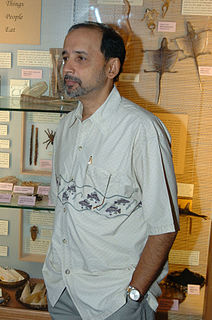Lieutenant Colonel Edward Frederick Kelaart was a Ceylonese-born physician and naturalist. He made some of the first systematic studies from the region and described many plants and animals from Sri Lanka.
Adenomus kandianus is a species of toad in the family Bufonidae endemic to Sri Lanka. It is a high-altitude species known only from few localities. The specific name kandianus means "from Kandy" and seems to suggest that the type material came from near the city of Kandy.

Adenomus kelaartii is a species of toad in the family Bufonidae. It is endemic to Sri Lanka, where it is found in the south-west of the island at elevations between 30 and 1,230 m. The specific name kelaartii honours Edward Frederick Kelaart, a Ceylonese-born physician and zoologist.

Duttaphrynus noellerti is a species of toads in the family Bufonidae. It is endemic to the rainforests of southwestern Sri Lanka. It is named after Andreas Nöllert, a German herpetologist and photographer who first noted the distinctiveness of the species.
Uperodon nagaoi, also known as the Nagao's pug-snout frog or Nagao's globular frog, is a species of frogs in the family Microhylidae. It is endemic to Sri Lanka and is known from the Central, Sabaragamuwa, Southern, and Western Provinces. The specific name nagaoi honours Eijiro Nagao, president of Marusan Securities who, through the Nagao Environmental Foundation, has supported research on Sri Lankan amphibians.

Pseudophilautus auratus, commonly called Golden shrub frog, is a species of frog in the family Rhacophoridae, endemic to Sri Lanka.
Pseudophilautus eximius is an extinct species of frog in the family Rhacophoridae. It was endemic to Sri Lanka. It is only known from the holotype collected in 1933.
Pseudophilautus extirpo, known as Blunt-snouted Shrub Frog, is an extinct species of frog in the family Rhacophoridae. It was endemic to Sri Lanka. It is only known from the holotype collected in 1882. The specific name extirpo is Latin meaning "destroy" or "eradicate" and refers to the apparent extinction of this species.

Pseudophilautus schmarda is a species of frog in the family Rhacophoridae. It is endemic to the central hills of Sri Lanka and is known from the Peak Wilderness Sanctuary, Agra Bopath, Horton Plains, and Pedro. The specific name schmarda honours Ludwig Karl Schmarda, an Austrian physician, naturalist, and traveler. Common names Sri Lanka bug-eyed frog and Schmarda's shrub frog have been coined for it.

Pseudophilautus variabilis, also known as the variable bush frog or variable bubble-nest frog, is a species of frog in the family Rhacophoridae. This now extinct species was endemic to Sri Lanka. Despite extensive searches in recent times, it is only known from collections prior to 1858. The reasons for its disappearance are unknown but probably involve habitat loss.

Pseudophilautus viridis, or the dull-green shrub frog, is a species of frogs in the family Rhacophoridae. It is endemic to Sri Lanka and occurs in the central hills of south-central Sri Lanka.
Pseudophilautus zal, known as White Blotched Shrub Frog is an extinct species of frogs in the family Rhacophoridae. It was endemic to Sri Lanka. It is only known from the type series consisting of three old museum specimens.

Taruga eques is a species of frog in the family Rhacophoridae. It is endemic to the central hills of Sri Lanka.
Pseudophilautus pardus is an extinct species of Sri Lankan shrub frogs in the family Rhacophoridae. Despite extensive surveys in recent years, the species is known only from a collection made prior to 1858. The reason for its extinction is unknown but probably relates loss of forests.

Pseudophilautus is a genus of shrub frogs in the family Rhacophoridae endemic to the Western Ghats of southwestern India and to Sri Lanka where the majority of the species are found. Many of them are already extinct. On the other, some species believed to be extinct have also been rediscovered.

Rohan David Pethiyagoda, is one of Sri Lanka's leading naturalists and a taxonomist on Freshwater fish of Sri Lanka.
Pseudophilautus simba is a species of frogs in the family Rhacophoridae endemic to Sri Lanka. It is only known from its type locality in the Morningside Forest Reserve, adjacent to the Sinharaja Forest Reserve, near Rakwana, southern Sri Lanka.

L. J. Mendis Wickramasinghe is a Sri Lankan herpetologist, taxonomist, naturalist,wildlife photographer. Overcome by an unusual childhood passion on snakes, inspired by the magical diversity of his motherland, he has spent over two decades of his life experiencing the forests across Sri Lanka.










